Blog provides NCERT solutions, CBSE, NTSE, Olympiad study material, model test papers, important Questions and Answers asked in CBSE examinations. References to Educational Sites and resources.
Monday, 4 November 2024
Saturday, 18 March 2023
Class 11 Informatics Practices - Introduction to Databases- Questions and Answers on MySQL (Part 1) #eduvictors #class11IP #class12IP #class11ComputerScience
Class 11 Informatics Practices
Introduction to Databases
Questions and Answers on MySQL
(Part 1)
Q1. What is database?
Answer: A database is an organized collection of data. The data are typically organized to model aspects of reality in a way that supports processes requiring this information. The term "database" can both refer to the data themselves or to the database management system.
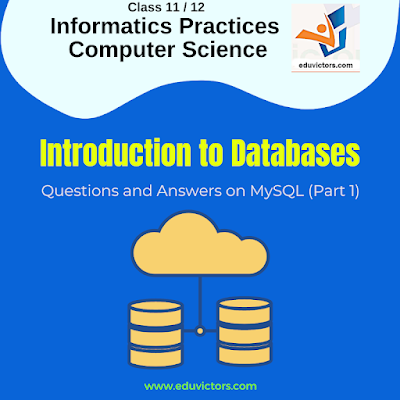
Wednesday, 14 September 2022
Class 11 - Informatics Practices - Python Snippets (Set-2) #Class11Python #cbseClass11 #Class11ComputerScience #Python #eduvictors
Class 11 - Informatics Practices - Python Snippets (Set-2)
Write Python Programs for the following problem statements:
1. Write a program in python to input marks in 5 subjects from the user and display the average marks.
2. Write a program in python to read details like name, class, age of a student and then print the details firstly in same line and then in separate lines.
3. Write a program in python to input a number and print its first five multiples.
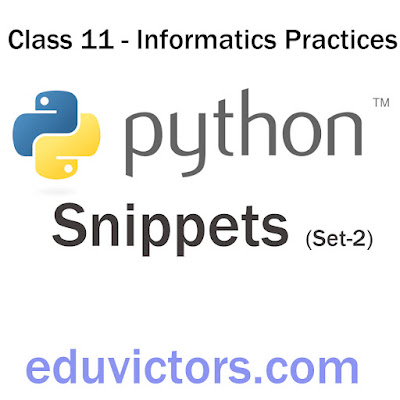
Sunday, 17 October 2021
CBSE Class 11 - Python Conditional Statements - Computer Science/ Informatics Practices (#class11InformaticsPractices)(#class11ComputerScience)(#python)(#eduvictors)
CBSE Class 11 - Python Conditional Statements - Computer Science/ Informatics Practices
Q1: What do conditional statements do?
Answer: Conditional statements let us write program to do different tasks or take different paths based on the outcome of the conditions.
Q2: What is meant by a control structure?
Answer: A control structure is a logical design that controls the order in which a set of statements execute.
Thre are three types of control structures:

Sunday, 3 January 2021
Worksheet on Database Management Systems - Class 10 / Class 11/Class 12 - Information Technology /Computer Science / Informatics Practices
Worksheet on Database Management Systems
Class 10 - Information Technology
Class 11/Class 12 - Computer Science / Informatics Practices
Directions: Fill in the blanks with suitable words.
1 _______ is a collection of related information.
2 _______ are the basic building blocks of a database.
3 Table is also known as ________
4 In a table, columns are also called ________ and rows are called _________.

Monday, 30 March 2020
Class 11 - Informatics Practices / Computer Science - Computer System Overview (Part-2) Questions and Answers (#eduvictors)(#class11InformaticsPractices)
Computer System Overview
Answer: A device through which data and programs from the outside world enter the computer system is called an input device. It converts the input data into a digital form that is acceptable by the computer system.
Q2: Identify the input device from the picture given below. Write one line description about each item .

Tuesday, 24 March 2020
Class 11 - Informatics Practices / Computer Science - Computer System Overview (Part-1) Questions and Answers (#eduvictors)(#class11InformaticsPractices)
Computer System Overview
Q1: What is a computer?
Answer: A computer is an electronic device, under the control of instructions stored in its memory that can accept data (input), process the data according to specified rules(Program), produce information (output), and store the information for future use.
The word 'computer' comes from the word 'compute' which means to calculate. Therefore, a computer is an electronic device that can perform arithmetic operations at high speed.
Q2: Why a computer is also called a data processor?
Answer: A computer is also called a data processor because it can store, process and retrieve data whenever desired.
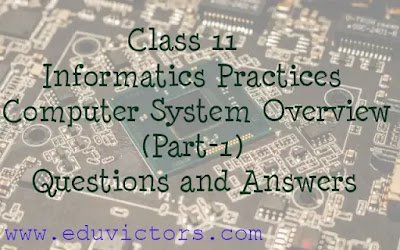
Thursday, 6 February 2020
CBSE Class 11 - Informatics Practices - Python Basics - Numpy Arrays (Part-1) - Question and Answers (#CBSEclass11Python)(#cbse)(#eduvictors)
Python Basics - Numpy Arrays

Thursday, 16 January 2020
CBSE Class 11 - Informatics Practices - Python Basics - List Manipulation (Part-2) - Question and Answers (#eduvictors)(#class11Python)
Python Basics - List Manipulation (Part-2) - Question and Answers

Wednesday, 8 January 2020
CBSE Class 11 - Informatics Practices - Python Basics - List Manipulation (Part-1) - Question and Answers(#class11InformaticsPractices)(#eduvictors)
Python Basics - List Manipulation (Part-1)
Q1: What is a list in Python?
Answer: List is a collections of items and each item has its own index value. It is the most versatile datatype available in core Python which can be written as a list of comma-separated values (items) between square brackets.
e.g.
[] # empty list
[1,2,3,4] #list of integers
[2.0, 4.56, 8.91, ] #list of floats
['Sunday', 'Monday', 'Tuesday'] #list of floats
['Nikita', 16, 'Class 11', True, 86.7] # list of mixed values

Wednesday, 1 January 2020
CBSE Class 11 - Informatics Practices - Python - String Manipulation (Part-2) - Question and Answers(#class11Python)(#eduvictors)
Python - String Manipulation (Part-2)
Q1: What are membership operators for strings?
Answer: Two membership operators are:
in Returns True if a substring exists in the given string otherwise returns false.
e.g. "xy" in "xyz" #returns True
"ab" in "xyz" #returns False
not in Returns True is a substring does not exist in the given string;
e.g. "ab" not in "xyz" #returns True
"xy" not in "xyz" #returns False
Q2: What is the output of the following?
str1 = "Hello World!"
str2 = "he"
str3 = "He"
str2 in str1
str3 in str1

Friday, 27 December 2019
CBSE Class 11 - Informatics Practices - Python - Type Conversion and Type Casting - Question and Answers(#class11Python)(#eduvictors)
Python Basics - Type Conversion and Type Casting
Answer: Type conversion means converting one data type to another data type. Python supports two types of type conversion:
1. Implicity Type Conversion
2. Explicit Type Conversion (also called Type Casting)
Question 2: What is implicit type conversion? Give an example.

Thursday, 26 December 2019
CBSE Class 11 - Informatics Practices - Python - String Manipulation (Part-1) - Question and Answers(#eduvictors)(#cbseClass11Python)
Python - String Manipulation (Part-1)

Friday, 20 December 2019
CBSE Class 11 - Informatics Practices - Python Literals - Question and Answers (#eduvictors)(#cbsecClass11Python)
Python Basics - Literals
CBSE Class 11 - Informatics Practices
Questions and Answers
Answer: A set of valid characters recognized by python constitutes character set.
Python (from version 3.x onwards) supports the Unicode text. It has the following character set:
Letters: A-Z,a-z
Digits: 0-9
Special symbols: Special symbol available over a keyboard
White spaces: blank space,tab, carriage return, newline, form feed
Other characters: Unicode
Question: Can I type in Hindi in Python 3?
Answer: Yes, Python supports Unicode text, hence one can use multiple languages including Hindi.
Question: What is a token?
Answer: Smallest individual unit in a program is known as a token. It can be:
1. Keywords
2. Identifiers
3. Literals
4. Operators
5. Punctuators

Monday, 9 September 2019
Class 11 Sample Question Papers (Mid-Term) 2019-20(#eduvictors)(#cbsepapers)
Class 11 Sample Question Papers (Mid-Term) 2019-20
Here are links of mid-term or SA1 SQPs:

Wednesday, 28 August 2019
CBSE Class 11 - Computer Science (C++) - User Defined Function - Q & A (#class11ComputerScience)(#cbsenotes)(#eduvictors)
Class 11 - Computer Science (C++)
User Defined Functions
SHORT ANSWER TYPE QUESTIONS
Q1(MCQ): A function’s single most important role is to
(a) give a name to a block of code
(b) reduce program size
(c) accept argument and provide a return value
(d) help organize a program well
Answer: (d) help organize a program well
Q2: Define a function. What is the name of one-statement description of a function?
Answer: A function is a subprogram that acts on data and often returns a value. The name of one-statement description of a function is procedure or prototype.
Q3: Function prototype is alternatively called. What is the statement specifically called that invokes a function?
Answer: A function prototype is alternatively called function declaration. The statement that invokes a function is specifically called function call.

Monday, 4 March 2019
CBSE Class 11 - Computer Science Annual Sample Question Paper (2018-19) (Set-1)(#cbsepapers)(#eduvictors)
CBSE Class 11 - Computer Science
Annual Sample Question Paper (2018-19)
(Set-1)
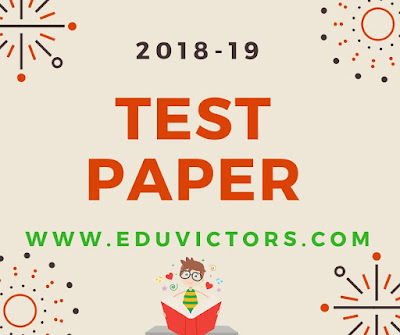
Monday, 15 October 2018
CBSE Class 11 - Computer Science (C++) - Sample Question Paper - (2018-19)(#eduvictors)(#cbsepapers)
CBSE Class 11 - Computer Science (C++)
- Sample Question Paper - (2018-19)

Friday, 24 August 2018
Class 9- 12/NTSE/CTET/Entrance Examination- Computer Awareness Quiz (#eduvictors)(#cbsenotes)
MCQs on Computer fundamentals and Computer awareness Quizzes links are provided here:
Computer Awareness Quiz
Computer Awareness Quiz Set-1
Computer Awareness Quiz Set-2
Computer Awareness Quiz Set-3
Computer Awareness Quiz Set-4
Windows Operating System Quiz
MS Office Quiz
Database Systems Quiz
Computer Fundamentals Quiz
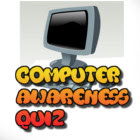
Friday, 20 April 2018
Entrance Exam/BCA/BBA/Class 11/Class 12 - Computer Awareness Quizzes (#eduvictors)(#cbsenotes)(#bcaentrance)
Computer Awareness Quizzes
Computer Awareness MCQs are available at eduvictors.com that may help you prepare for BCA/BBA entrance tests and Computer Science related examinations.




